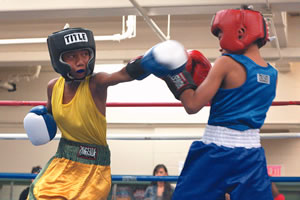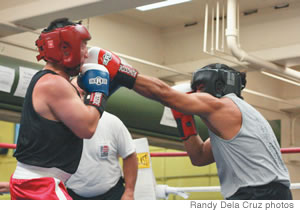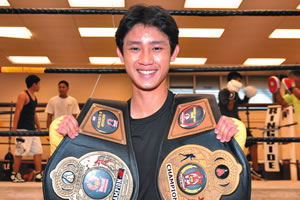The Sport That Won’t Go Away

Kekoa Siaris (left) lets loose a bomb against Isaiah Bright
Thought to be a dying sport because of MMA, it turns out MMA is actually driving more people into the ring
There once was a time when boxing ruled Hawaii. Certainly football, whether high school or collegiate, has always been a popular draw, but believe it or not, there was a time when big bouts would be the talk of the Islands. And the stars weren’t limited to one race, ethnic background or island of origin. Whether you were Polynesian, Asian, haole or from Maui, O’ahu or Kaua’i, there was always someone to root for.
But those days are long gone. Weakened by uninteresting fighters and cable television, and given the death blow by mixed martial arts, the sport seems to have wilted away.
Not so, says Bruce Kawano, president of Amateur Boxing of Hawaii. As it turns out, boxing is not finished. In fact, it is getting bigger, and MMA has actually helped.
At gyms, opulent and otherwise, men and women, no matter the age, are skipping rope and exchanging blows. Kalakaua District Park Boxing Gym in Kalihi is one such place. Inside its well-worn doors are the sights and sounds of training. Leather hits leather as a young teen, under the watchful eyes of his coach, rotates at the waist to deliver an even more powerful upper cut. In another section, a mother chases down her energetic child just after going the distance with a heavy bag, and in an adjoining ring a grade-schooler, nearly invisible behind his seemingly oversized practice gloves and head gear, goes through his first few lessons. For the great majority of fighters at this gym, and the approximately 35 other clubs throughout the state, boxing is recreation, a form of exercise that satisfies the competitive juices.

Kaleohano Tolentino (right) throws out a well-placed jab at Sgt. Corky Sponcey
For a select few, the hours of daily training could be their ticket to something bigger.
Justly Laquihon could be one of those rare ones. The McKinley High School junior began fighting at the age of 8 and currently boasts a 15-1 amateur record, including winning two consecutive Ringside World Championships at the 106-pound division.
“It’s pretty much been my life,” says the 16-year-old, who dreams of following in the footsteps of his hero, Manny Pacquiao. “I want to be a professional, but if that doesn’t work out I’ll have my education.” Laquihon, who is carrying a 3.5 GPA, plans to attend either UNLV, for its closeness to the fight industry, or Oregon, for its medical programs. He hopes to be a nurse practitioner. But first things first. The next step is the 2011 Junior Olympics.
“That is the most important event for all amateur boxers. If you win that you may get a spot on the Olympic team, and that is something I want to do. I want to represent the U.S. It is something I always dreamed of. It just stokes the fire for me to work harder.”
Talk of the Olympics brings not only a smile to his face, but to his prideful father who introduced his son to the sport.
Laquihon, whose family emigrated from the Visayas region of the Philippines, is well-aware of the legacy of Filipino boxers in Hawaii and elsewhere.
“I really feel that pride. Even though I am from Hawaii, just that feeling of representing Filipinos is important. I look at Pacquiao’s impact on the Philippines and want to do that too. I don’t know if I can, but I want to be great.”
The history of boxing in Hawaii goes back to the games of the Makahiki festivals, where the contests were part of the annual celebrations for the god Lono. It took a few more years before anyone made the papers.

Justly Laquihon and his two world title belts
Hawaii’s first fighter of note was likely “Sailor” Tom Sharkey, who began his professional career in Hawaii in 1893 while stationed aboard the USS Philadelphia. The hall of famer gained his greatest fame in 1899 when he went 25 rounds with heavyweight champ James J. Jefferies.
The military dominated local boxing at the beginning of the last century. In fact, until 1929 boxing was illegal in Hawaii unless it was sponsored by the military. Of course, all over town fighters were testing themselves in illegal matches that the authorities rarely bothered to stop. To get around these rules, promoters often labeled the matches as exhibitions. Sometimes they even were. In 1894, while en route to Australia, former bare knuckle champion John L. Sullivan wowed Honolulu’s boxing fans for a few rounds.
For most of its history, boxing has suffered from an image problem. It is a violent sport, no doubt, but to those who embrace it the benefits outweigh any problems brought by those who don’t see it as sport.
“You think the sport of boxing is about fighting, but you need to be dedicated,” says Laquihon, who notes that those who enter the gym to be a better bully rarely last more than a month. “It’s not easy. You have to want to do this. It’s not about being a tough guy and showing off at school.”
While Laquihon dreams of boxing glory, others have goals that are much easier to attain.
Gardenia Sims is a 29-year-old mother of three who started training two years ago on the advice of a friend. Concerned about her weight following the birth of her youngest son, she agreed to give boxing a try. She would work out, but fighting was out of the question. That is, until one of the coaches asked why she was wasting her time just training.
“I said, ‘What is that supposed to mean?’So I went in there one day, and it just clicked. Ever since then I’ve been competing, and I never in my life thought I would be competing,” says the smiling and now-35 pounds lighter fighter.
Sims is older than most who take up the sport. And like the mythical Maggie Fitzgerald in Million Dollar Baby, she had people wondering if she was too old to compete.
“I get that all the time,” she says. “People like my dad think I should be at home and be a full-time mom, and he thinks boxing is something I should have started when I was younger. I don’t see it that way. I see it as a goal I never had, and now that I want to achieve. Look how much I have accomplished at 29.”
Kawano says the popularity of the sport among women continues to grow, and the reason may be that the 2012 Olympics in London will feature women’s boxing for the first time. Sims, who is ranked sixth nationally in her weight class, says she would love to compete, but family must come first. Though she trains seven days a week, boxing is now a hobby, and her kids’athletic activities get first priority.
But even if she never competes again, she wants to set an example. “That’s what I want to show my kids, that Mommy isn’t only full-time mom. I have goals, I can do stuff I want to do.”
And so can they.
You must be logged in to post a comment.




There are no comments
Add yours